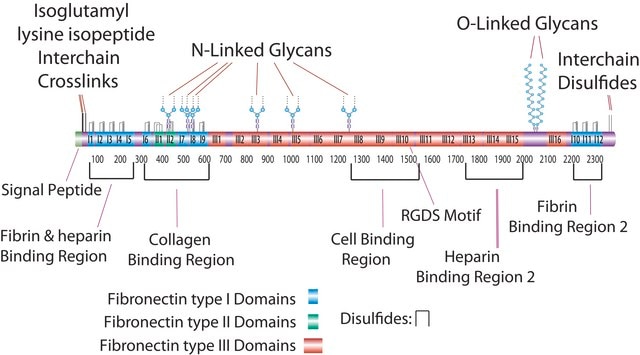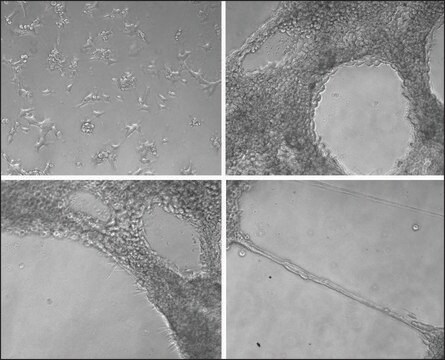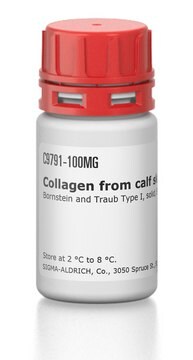5006
PureCol™
protein from bovine hide, suitable for cell culture
Recommended Products
biological source
protein from bovine hide
Quality Level
sterility
sterile-filtered
Assay
99.9%
form
lyophilized
packaging
pkg of 15 mg
technique(s)
cell culture | mammalian: suitable
shipped in
wet ice
storage temp.
−20°C
Related Categories
General description
It is ideal for coating of surfaces and providing preparations of thin layers for culturing cells. PureCol™, lyophilized form is not recommended for the formation of a solid gel. PureCol™ collagen is provided in user-friendly packaging for use and storage. This product is supplied as a sterile lyophilized powder.
Application
- in collagen gel preparation for the 3D sprouting assay with human umbilical vein endothelial cells (HUVEC) spheroids
- to coat Costar® Transwell® Inserts plates before cell migration assays with bladder smooth muscle cells (BMSC)
- to coat culture plates for collagen degradation assay with breast cancer cell lines
Preparation Note
Legal Information
Storage Class Code
11 - Combustible Solids
WGK
WGK 1
Flash Point(F)
Not applicable
Flash Point(C)
Not applicable
Regulatory Information
Certificates of Analysis (COA)
Search for Certificates of Analysis (COA) by entering the products Lot/Batch Number. Lot and Batch Numbers can be found on a product’s label following the words ‘Lot’ or ‘Batch’.
Already Own This Product?
Documents related to the products that you have purchased in the past have been gathered in the Document Library for your convenience.
Difficulty Finding Your Product Or Lot/Batch Number?
How to Find the Product Number
Product numbers are combined with Pack Sizes/Quantity when displayed on the website (example: T1503-25G). Please make sure you enter ONLY the product number in the Product Number field (example: T1503).
Example:
Additional examples:
705578-5MG-PW
PL860-CGA/SHF-1EA
MMYOMAG-74K-13
1000309185
enter as 1.000309185)
Having trouble? Feel free to contact Technical Service for assistance.
How to Find a Lot/Batch Number for COA
Lot and Batch Numbers can be found on a product's label following the words 'Lot' or 'Batch'.
Aldrich Products
For a lot number such as TO09019TO, enter it as 09019TO (without the first two letters 'TO').
For a lot number with a filling-code such as 05427ES-021, enter it as 05427ES (without the filling-code '-021').
For a lot number with a filling-code such as STBB0728K9, enter it as STBB0728 without the filling-code 'K9'.
Not Finding What You Are Looking For?
In some cases, a COA may not be available online. If your search was unable to find the COA you can request one.
Articles
3D cell culture overview. Learn about 2D vs 3D cell culture, advantages of 3D cell culture, and techniques available to develop 3D cell models
Extracellular matrix proteins such as laminin, collagen, and fibronectin can be used as cell attachment substrates in cell culture.
Our team of scientists has experience in all areas of research including Life Science, Material Science, Chemical Synthesis, Chromatography, Analytical and many others.
Contact Technical Service


